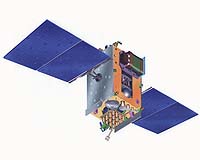 |
Dulles, VA (SPX) Apr 20, 2010 Orbital Sciences is in final campaign mode preparing for the first launch of its Minotaur IV rockets in support of the Defense Advanced Research Projects Agency's (DARPA) Hypersonic Technology Vehicle-2 (HTV-2) program. The Minotaur IV launch vehicle is based on decommissioned Peacekeeper rocket motors that Orbital integrates and upgrades with modern avionics and other subsystems to produce a cost-effective booster based on flight-proven hardware. Subject to final preparations and favorable weather conditions, the mission will originate from Space Launch Complex-8 at Vandenberg Air Force Base, CA, with its first available launch window from 12:00 p.m. to 5:00 p.m. (PST) tomorrow, April 20, 2010. For the HTV-2 mission, Orbital will fly a three-stage Minotaur IV "Lite" version of the rocket to carry out the suborbital flight trajectory. The Minotaur IV will propel the HTV-2 air vehicle into the upper atmosphere, where it will be released. The HTV-2 will then descend at hypersonic speed into the Pacific Ocean near Kwajalein Atoll in the Marshall Islands. The Minotaur IV rocket is the newest in the Minotaur family of launchers that Orbital produces for the U.S. Air Force under the Orbital/Suborbital Program-2 contract. The first orbital mission of the Minotaur IV will take place later this year when it launches the Air Force's Space Base Space Surveillance (SBSS) satellite. "The first flight of the Minotaur IV rocket ushers in an all-new capability for the Air Force and other U.S. Government customers at a time when reliable, cost-effective missions are at a premium," said Mr. Ron Grabe, Orbital's Executive Vice President and General Manager of its Launch Systems Group. "Building on the outstanding record of the 16 previous flights of the Minotaur family, all of which have been successful, we are excited to begin flying the Minotaur IV rocket for our Air Force customer." The debut of Minotaur IV begins a series of launch vehicle system introductions that will highlight Orbital's position as the most active current developer of new rocket systems in the world. Beginning with Minotaur IV, Orbital is scheduled to complete the development and carry out the first flights of five new space and strategic launch systems in the next two and a half years. The four other launch vehicles are the Launch Abort System for NASA's Orion program, the two-stage interceptor booster for the Missile Defense Agency's Ground-based Midcourse Defense system, the Taurus II medium-class space launch vehicle for NASA and other customers, and the Air Force's Minotaur V rocket that is scheduled to launch NASA's LADEE lunar mission in 2012. Mr. Grabe also stated, "With the introduction of several new space launch vehicles in the next couple of years, combined with our heritage Pegasus, Taurus and Minotaur vehicles, Orbital will offer its defense and intelligence, civil government and commercial satellite customers the world's most complete and proven line of launchers for small- and medium-class satellites weighing up to 12,000 lbs."
The HTV-2 Mission The key technical challenges of the HTV-2 program are the design of an innovative high lift-to-drag aerodynamic shape, advanced lightweight but tough thermal protection structures, materials and fabrication technologies, autonomous hypersonic navigation guidance and control systems, and an autonomous flight safety system.
The Minotaur IV Minotaur IV utilizes three government-furnished solid rocket motors from decommissioned Peacekeeper ICBMs and a commercial solid rocket upper stage. Minotaur IV builds on a long heritage of launch systems with over 50 flights of each core stage and is capable of launching payloads up to 3,800 lbs. (1,730 kgs.) to low Earth orbit.
Share This Article With Planet Earth
Related Links Orbital Sciences Rocket Science News at Space-Travel.Com
 GSAT-4 Rocket Lost, But Precious Payload Safe
GSAT-4 Rocket Lost, But Precious Payload SafeBangalore (IANS) Apr 19, 2010 A fateful but providential decision by the Indian Space Research Organisation (ISRO) saved a precious Indo-Israeli science payload from crashing into the sea in the failed GSLV launch mission Thursday. Under the original plan, the ultraviolet telescope called TAUVEX was to be carried by GSAT-4, which plunged into the Bay of Bengal after the indigenously built cryogenic stage failed to fire ... read more |
|
| The content herein, unless otherwise known to be public domain, are Copyright 1995-2010 - SpaceDaily. AFP and UPI Wire Stories are copyright Agence France-Presse and United Press International. ESA Portal Reports are copyright European Space Agency. All NASA sourced material is public domain. Additional copyrights may apply in whole or part to other bona fide parties. Advertising does not imply endorsement,agreement or approval of any opinions, statements or information provided by SpaceDaily on any Web page published or hosted by SpaceDaily. Privacy Statement |